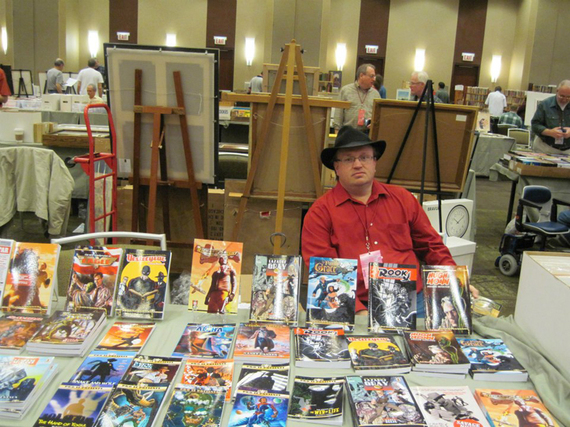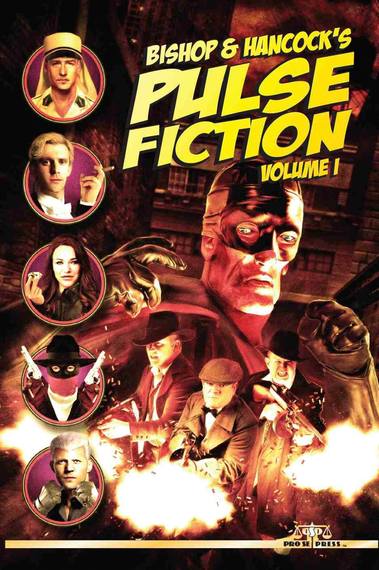My exclusive interrogation of Tommy Hancock, high-end pulp pusher and head of the Pro Se Productions pulp cartel, continues...
Was it a sudden epiphany leading you to start Pro Se, or was it a deliberately planned conspiracy to make the world a better place through pulp?
Actually, the whole thing was more about me hearing opportunity knock with the right password. In my time in juvenile court, I ended up working with an attorney who, in similar and different ways, had the same interest I did in creating great stuff people would enjoy and maybe making a little money from the effort.
The attorney, Fuller Bumpers by name -- yes, yes, it's a real name -- had been a writer in Hollywood and an actor. He had worked with everyone from Judge Judy to Robert DeNiro, but had returned to Arkansas to hang out a shingle and raise a family. Still interested in being creative, Fuller had established Pro Se Productions and was looking for a specific focus. I came on board as we got to know each other, first moving in the direction of original audio drama. We produced a few things, ranging from public domain boys' adventure stuff from the early 20th Century to our own original ideas. But about the same time, I found myself published in the New Pulp world for the first time.
Derrick Ferguson, one of my best friends thanks to the wonders of technology, and one of the tops in New Pulp writing, pointed out there was a company taking submissions for pulp short stories written by modern types. This led me to Ron Fortier and Rob Davis at Airship 27 Productions. At the time the company was -- and still is -- making a huge mark on what we now call New Pulp. I wrote Ron and Rob a Virgil Earp story for an anthology. It was published, and the writer's die was cast for me.
Being an inquisitive investigator -- okay, nosy -- I began looking into publishing as a possible direction for Pro Se. I quickly found myself knee deep in the growing corner of genre fiction we called New Pulp. What I found had wonderful possibilities -- if the right people came together in just the right way and had the patience to work at a singular goal for years, there could be something great for all involved.
Readers who never knew they enjoyed the sort of stuff many of us want to write would discover New Pulp. Authors who would never see the light of day via traditional publishing houses, and who should have seen the light of many days would get published. Even already well-established writers who wanted to cut loose and write descriptive, over-the-top pulp could have a place to do it. I took all of those inspirations, rolled it around in the rather discombobulated mass in my head I refer to as a brain, and laid it all out for Fuller -- resulting in the concept of Pro Se Productions being born in 2010.
What was your initial vision/goal for Pro Se and how has it grown into the insidious pulp empire it is today?
Insidious? Now, I'm not so sure... well, okay, maybe...
The initial vision for Pro Se is still the path we're beating today. Without going into minutia, Pro Se is built on three five-year plans, with a short prologue phase.
The prologue phase began in 2010, when Pro Se first entered the New Pulp field with a line of magazines -- Masked Gun Mystery, Peculiar Adventures, and Fantasy and Fear. All three were very much styled after classic pulp magazines. Using that model, we built a decent stable of writers interested in continuing to work for Pro Se. We made connections while continuing to research and explore the direction Pro Se needed to go in order to become something special.
In 2011, we began publishing novels and anthologies as we kicked off our first five-year plan, which takes us to the end of next year. This phase continued our initial intent of building a great catalog filled with writers from New York Times bestsellers to brand new writers who readers just had to experience.
In achieving this early goal, we've also helped define New Pulp more clearly, but also opened up was previously a niche interest to hordes of new fans and possibilities. Embracing the fact New Pulp and genre fiction are terms related to the sort of literature people want to write and read has gone a long way to establish Pro Se and broaden the horizons of the market for other independent writers and publishers inspired by pulp.
As the power behind one of the largest modern pulp cartels, what happens during a typical day of pushing pulp?
It's a lot of hiding the bodies and intentionally forgetting where you put them.
Actually, this thing I call a job is a whole lot of fun for me. By nature, I am a person who needs to be busy. I like to have dozens of plates loaded with armed bombs spinning all at once, which is what daily work with Pro Se has become. To boil it down just to a few things in a list is nearly impossible -- which is why I'm willing to try.
Daily work for a pulp pusher? The best part is working closely with the fantastic individuals who make up Pro Se's staff, always giving of themselves and their time -- because nobody, including me, is getting rich doing this stuff. I have a terrific Director of Corporate Operations who is directly responsible for our editors. However, I still spend a lot of time interacting with our great editing staff and work directly with the fantastic artists responsible for the covers of our books. I also have a truly awesome Submissions Editor who I stay in touch with as new works come to us looking for a home at Pro Se.
I am constantly in contact with our writers, both those who have been with us since the start, and those who are coming on board now. I am actively recruiting when needed while also conducting research and marketing. One of the biggest aspects of what I do daily is always looking for the next way to expand, the next way to promote, how to improve what we are doing to make the company operate better and expose more Pro Se creators to more readers, making this effort more profitable and beneficial for all.
Amongst all the chaos, I work with the talented formatters who make our books look good and make sure the books get published. I handle all the interactions with vendors and other companies with whom we may be involved. Basically, I do a lot of talking, of pushing and pulling, and putting a shine on already sparkling work.
Coming up in Part 3 of my exclusive interrogation of pulp pusher Tommy Hancock, we put on the sap gloves and bring things to a dramatic conclusion...
ABOUT THE INTERVIEWER: Novelist, screenwriter, and television personality, Paul Bishop spent 35 years with the Los Angeles Police Department, where he was twice honored as Detective of the Year. He continues to work privately as an expert in deception and interrogation. His fifteen novels include five in his LAPD Homicide Detective Fey Croaker series. His latest novel, LIE CATCHERS, begins a new series featuring LAPD interrogators Ray Pagan and Calamity Jane Randall.
* WEBSITE * TWITTER * FACEBOOK * AMAZON *


